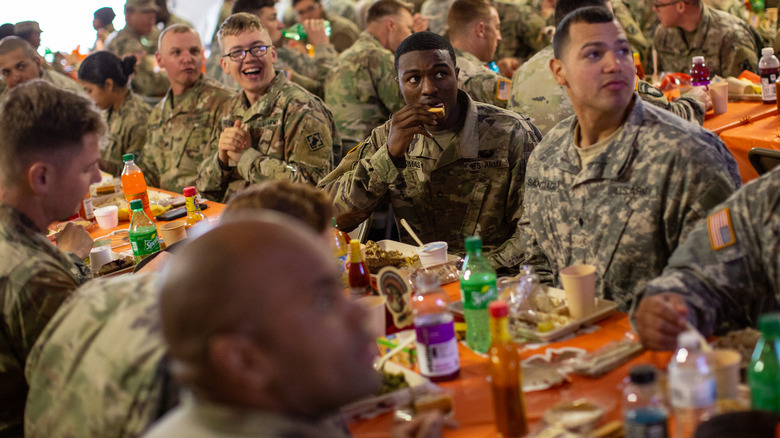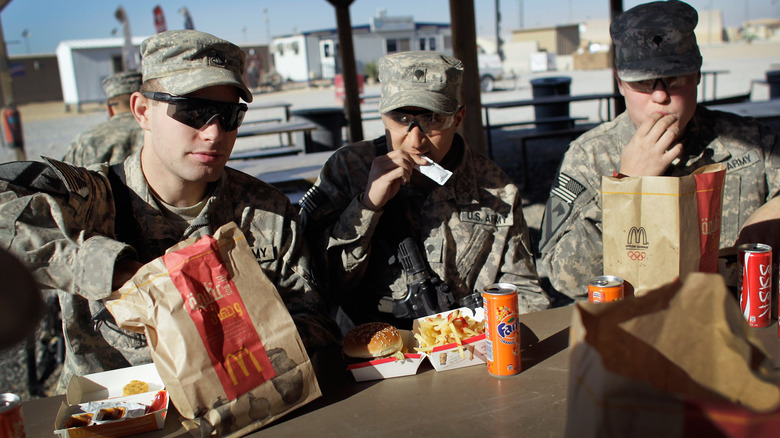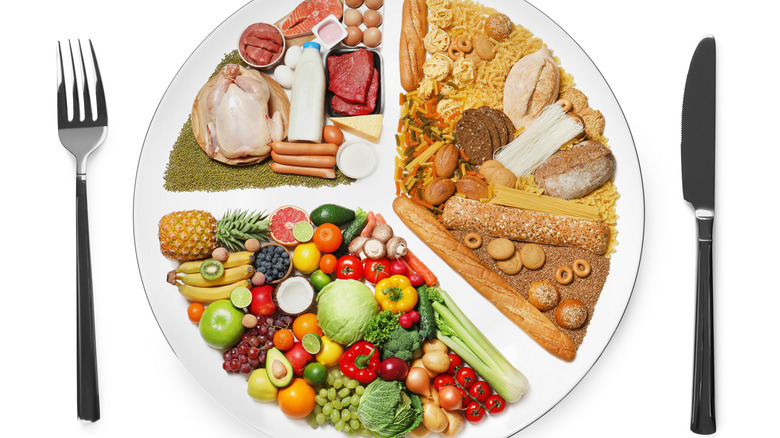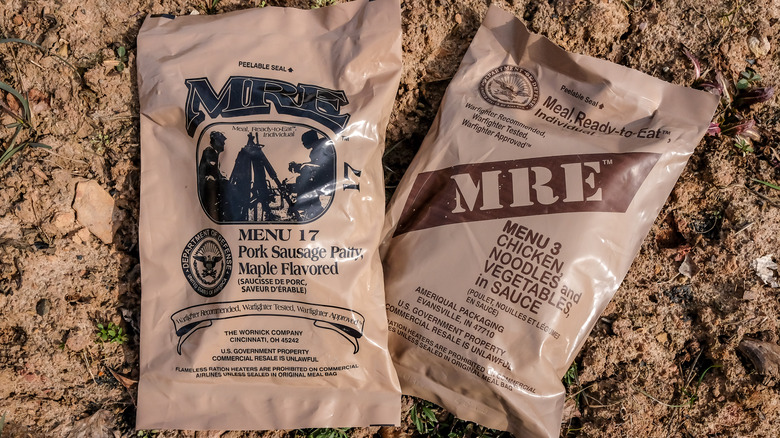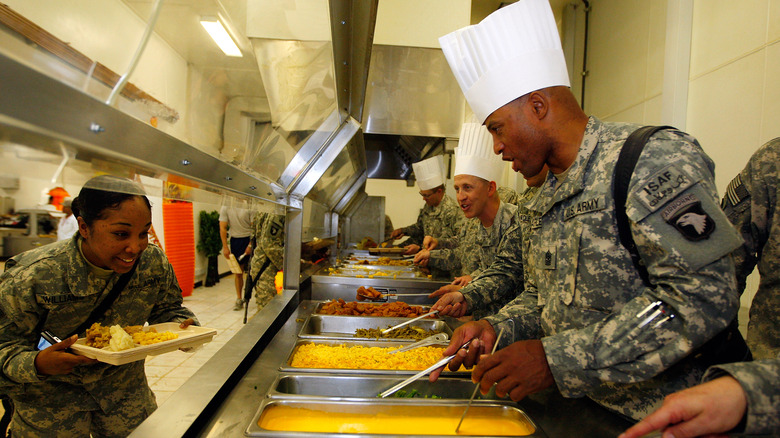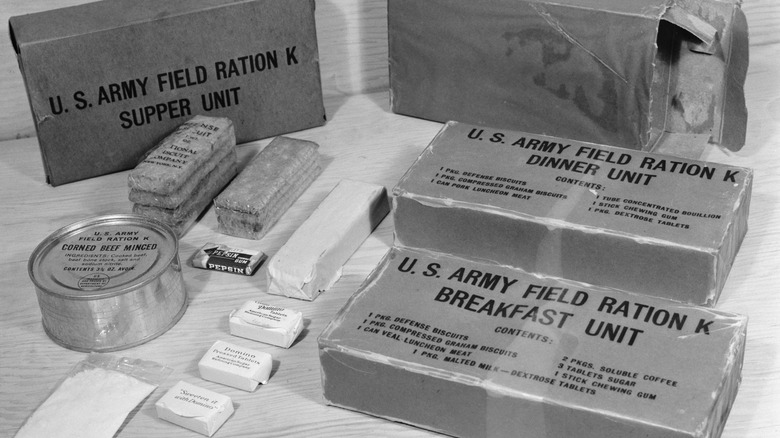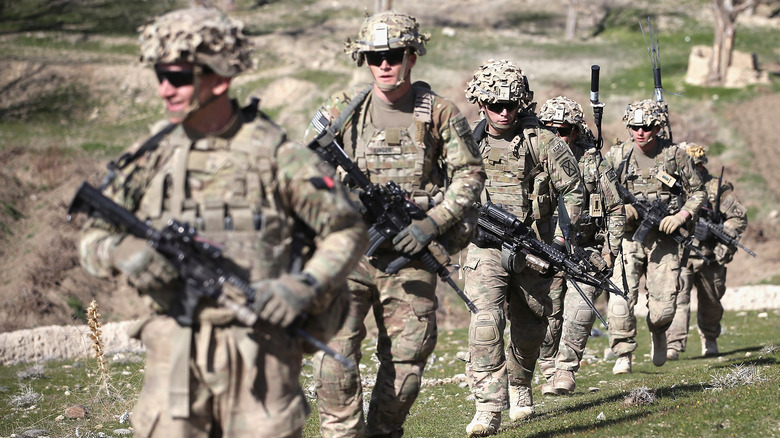Weird Rules The U.S. Army Has About Food
Ensuring the U.S. is eminently prepared for any and all enemies is a crucial factor in preserving the country's independence. The need for a well-trained and robust military is essential in deterring any challenges to our sovereignty. Of course, while we'd never play favorites with branches of the armed forces, only one can claim the title of the nation's largest and oldest: the Army (via Department of Defense).
If you've ever wondered about the journey an average citizen takes to become an "Army strong" soldier, well, it all starts with food. Food is fuel for the human body after all, akin to gasoline and cars. Even a Ferrari won't operate at peak performance on low-quality fuel, so in order for an Army enlistee to become a finely-tuned machine, proper nourishment is key.
With that in mind, it makes perfect sense that the Army (and the entire U.S. military) has a fairly particular set of requirements regarding what service members eat. From the type of food allowed during training to how it must be prepared, let's explore a few of these regulations and examine some of the weird rules the Army has about food.
Troops eat first, officers eat last
The U.S. Army instills a mindset of absolute equality among troops, and it's easy to see why. Fostering a culture where no one person is more important than any other, regardless of rank or length of service, helps maintain the all-for-one mentality needed to elevate the unit, squad, and country above the individual self. In that vein, this thought process explains one of the Army's more well-known (if unwritten) rules: Troops eat first and officers eat last (via CBS News).
The rationale behind this rule isn't hard to grasp — it's a fairly straightforward way to build trust between officers and their subordinates. "It's sort of like leading by example," Charlie Rouse, a current Major in the Army National Guard (and former active duty member), told Mashed in an interview. "Being selfish is a sign of bad leadership, and a good leader won't put themselves above anyone else."
By ensuring troops eat before them, officers demonstrate compassion for their welfare. Seniority may offer special privileges in other walks of life, but it wouldn't fly from a commanding officer in the Army. After all, if a leader won't make genuine sacrifices for their troops, why should the troops make sacrifices for them?
Consuming food with hemp ingredients is prohibited
Even though 37 states have legalized marijuana for medical and/or recreational use as of February 2022 (via National Conference of State Legislatures), it still remains a Schedule I Controlled Substance making it illegal on a federal level. Consequently, the U.S. Army doesn't only prohibit soldiers from using marijuana — it also restricts the consumption of the increasingly-common food ingredient, hemp, aka marijuana's non-psychoactive cannabis counterpart.
Despite recent research demonstrating genuine health benefits associated with consuming hemp (via WebMD), the federal illegality of cannabis no matter the form clearly prohibits Army personnel from eating foods containing it. This includes the popular Strong & Kind line of KIND bars which contain hemp seeds and are consequently no longer sold at U.S. Army commissaries by 2015.
There's no doubt that individual states' rights are enshrined in the Constitution, as they should. But just because a state is legally allowed to decriminalize marijuana doesn't mean that members of the U.S. Army (serving in a federally-funded military branch) can flout federal laws and regulations in favor of state-level ones.
Soda is banned at all meals during Initial Military Training
Soda — or pop, if you prefer – has taken a hit in the past couple of decades. The plethora of studies illustrating the long-term health risks associated with soda consumption, particularly high-sugar options (via Harvard Health), has reduced its appeal as an everyday beverage. Given that it offers very little nutritional value or positive impact, it makes sense that the U.S. Army has prohibited soda at dining facilities during basic training, according to the 2016 Army Food Program Implementation Guide for Initial Military Training.
Frankly, you can understand why the Army would want to limit a recruit's access to soda, at least at the start. After all, very few individuals enter basic training in the physical or mental shape required of a soldier — a physically strong specimen who's emotionally prepared for anything. In light of the U.S. Army's 2010 Soldier Athlete Initiative which included an emphasis on proper nutrition and understanding the way certain foods impact well-being and performance, the rationale behind restricting a beverage with no real benefits is abundantly clear.
The Army doesn't seem to ban members from drinking soda once they've completed their initial basic training. But the importance of Initial Military Training and the need to mold recruits into what is expected of a member of the U.S. Army makes soda an empty, unnecessary indulgence at this stage.
Nutrition education materials must be provided at all dining facilities
There's no doubt the military lifestyle is incredibly regimented. The extreme commitment to discipline and order is obviously necessary for the U.S. Army to function at its best. Yet its members aren't mindless robots incapable of independent thought or action. So rather than forcing them to follow an extremely healthy eating plan, the Army provides a bounty of information — even requiring its dining facilities have nutrition education materials available at all times.
Dictated in the 2019 Army Food Program, the guideline requiring these informative materials at dining facilities is fairly logical. Frankly, is there a better place to try and nudge a person toward healthy eating than when they are actively choosing what to eat? Dining areas must also offer a clear and simple path as to where to seek further information. This includes the promotion of the Go for Green program, which establishes "fueling standards" for U.S. Army dining facilities.
Meal periods must be at least 90 minutes when possible
Life in the military can be brutal. Not to say it's inherently miserable, just that a lot is asked of service members. While declaring you support the troops is all well and good, it means a lot more when that appreciation is tangible. So it's no surprise the Army's 2019 Food Program Guide requires three 90-minute meal periods for troops whenever possible.
Of course, that last phrase — whenever possible — certainly plays a big hand in how often this requirement is followed. After all, if a unit is deployed on a days-long mission, or (God forbid) engaged in active combat, finding 90 minutes for a meal may not be feasible. But ensuring troops eat at appropriate intervals remains of paramount importance under any circumstance. As current Major in the Army National Guard, Charlie Rouse, told Mashed, "Any good leader will find the time for meals."
Considering the average lunch break for U.S. workers was 36 minutes in 2017 (per Statista), it's incredible the Army allots as much time as it does for meals. But in a world where many politicians talk a big game about supporting the troops without following through, it's heartening to know the Army itself strives to take genuine care of its members.
Ready-to-Eat meals must remain appetizing and stable in extreme conditions
While it's certainly true that combat rations (including Meals, Ready-to-Eat (MREs), the most common type of field ration used by the U.S. Army, per Human Performance Resources by CHAMP) are unlikely to win any James Beard awards, it doesn't mean deployed troops are stuck with freeze-dried dreck. In fact, thanks to the Army's Combat Feeding Directorate, scientists are continuously working to provide complete meal options that can withstand extreme conditions and that soldiers will actually enjoy (via U.S. Army).
Somewhat similar to astronaut food, MREs are highly-processed, nutrient-dense field rations designed to stay shelf-stable for up to three years at 80 F (via Defense Logistics Agency). Each MRE contains an entree, side, dessert, condiments, and beverage mix, and can be eaten as is or warmed with an included flameless heating device. Given the strict preservation requirements for MREs, a number of scientific and chemical processes are needed to create meals that are both long-lasting and delicious.
The idea of army chow may conjure images of overly processed barely edible trays of so-called food. But thanks to dedicated U.S. Army personnel and civil servants like those at the Natick Soldier Research, Development and Engineering Center (in Natick, Massachusetts), soldiers on deployment may find their MRE choices a bit more palatable than expected.
Dining facilities must provide a wide selection of diverse foods
You might be under the impression that the U.S. Army treats its soldiers with a "you get what you get and you don't get upset" type of mentality. Thankfully, for those men and women who protect our freedom, that line of thought is sorely mistaken. In fact, the Army doesn't just ensure its members are well-fed on seemingly anything their heart desires. It requires that dining facilities contain a diverse variety of options at all meals, mandating menus offer "appealing, nutritious, and wholesome food choices [...] from each food group," according to the 2019 Army Food Program.
As the 2016 Initial Military Training guide instructs, dining facilities "must provide variety, contrast in texture, flavor, and color" with menu selections. Additionally, during this initial training period, dining facilities are required to offer an almost staggering amount of beverages, fruits, vegetables, entrees, side dishes, breads, condiments, and desserts at each meal.
In the past, hungry troops may have had their pick of any number of incredibly indulgent choices, from fried foods to rich desserts (via Slate). But the U.S. Army's renewed emphasis on nutrition in recent years, including its Go for Green program and standards, means many of those formerly unhealthy choices have been replaced by smarter, healthier — yet just as mouth-watering — choices.
Salad bars need to offer a ton of variety
The dire importance of ingesting fruits and vegetables daily is widely preached in modern society. The notion of creating a rainbow of food on one's plate may be aimed at children (via Have a Plant), but it's a simple practice the vast majority of adults could benefit from too. Perhaps the monumental hand that fresh produce plays in overall health and wellness explains the U.S. Army's rules regarding well-stocked salad bars during Initial Military Training.
As stated in the 2016 Food Program Guide for Initial Military Training, a salad bar's leafy component must be composed of 50% dark green leaves, as well as a minimum of 10 fresh vegetables as toppings. Additionally, a healthy legume and seed option, several types of oils and vinegars, and at least seven different salad dressings (five of which must be low-fat) are required.
The mandate to provide training troops with diverse salad bar offerings may stem from the 2010 Soldier Athlete Initiative that prioritized healthy eating. But the need to reward our men and women in uniform with a healthy variety during training (literally and figuratively) may play a hand in this requirement, as well. After all, it only helps boost morale when folks aren't forced to eat the same food, every day, at every meal.
It mandates a holistic approach to dining and nutritional requirements
Since the turn of the 21st century, there seems to have been a societal shift regarding wholeness. A holistic mindset toward health — where a person's body, mind, and soul (however you define it) are seen as intimately connected — has become widely popular across all aspects of modern society. The U.S. Army is no exception, and in 2020, it began mandating a holistic approach toward its members' overall fitness — including the types of food served at dining facilities.
In fact, according to its Holistic Health and Fitness guide from 2020, "the Army's doctrine for readiness training" is now viewed almost exclusively through a holistic lens. The guide highlights the immense importance of proper nutrition in improving health and includes the holistic steps needed to obtain "nutritional readiness" to set soldiers up "to meet the physical and nonphysical demands of any duty or combat position."
You are what you eat, as the old adage goes. So if you eat garbage food, you're apt to feel like garbage, both physically and mentally. The U.S. Army understands the innate connection between each aspect of a person and prioritizes a holistic path toward health and fitness as a result. After all, homeostasis can only be achieved when your whole body is balanced and in sync.
Combat rations must pass rigorous testing after development
Whether an army squadron is traveling on alert through an unfamiliar area or engaged in an active war zone, remaining focused and motivated in the field is critical to a mission's success. Of course, the physical and mental toll taken when enduring those grueling conditions can't be oversold. Ergo, a combat ration needs to satisfy a soldier's stomach and taste buds — which is why the U.S. Army's Combat Feeding Directorate mandates a strict research and development process for combat rations before sending them to the field.
Scientists work tirelessly to produce stable and appealing new food for combat rations, eager to create delectable meals that reward those brave troops with the food they crave. With a battery of tests required before any food is approved for use, some likely never see the light of day. But others, like the first pizza developed for MREs in 2018 (via U.S. Army), can provide a modicum of comfort to deployed troops — as well as a small reminder of home.
There's no doubt being deployed in the field can be a hellish experience for soldiers. Given this, it's good to know the U.S. Army strives to take care of those courageous people by offering the absolute best food it can produce.
Food service management boards must regularly meet and review nutritional offerings
The notion of food as fuel has clearly informed how many modern Americans approach nutrition, including the Army, which refers to its 2016 Food Guide as a "Soldier Fueling Initiative." Of course, since the Army understands no dietary approach can (or should) remain static forever, it utilizes food service management boards to "review the garrison menu standards to maximize implementation" at dining facilities, according to the 2019 Army Food Program.
Food service management boards meet regularly to ensure all dining facilities don't just meet the minimum standards required but exceed them whenever possible. It "provides opportunities to work out and improve food service matters across the Central Command area of responsibility," as Sergeant 1st Class, Anthony Darris, told U.S. Army Central Newsroom in 2018.
There's no denying the value of collaboration in all areas of the U.S. Army, so it's no mystery why food service management boards exist within the military branch. After all, if the Army goes above and beyond to make sure its troops are always happy and healthy foodwise, they'll respond in kind when their efforts are needed.
Many common dietary supplements are banned
Trying to keep track of the almost ungodly number of dietary supplements for sale in the U.S. can be overwhelming. Since most dietary supplements aren't regulated by the FDA, purchasing an item without proper research is a risky endeavor. Of course, the risk only increases when you belong to an organization that strictly regulates what you can and can't put in your body — as is the case with the U.S. Army, which bans a number of common supplements among members (via Military Times).
The Army doesn't exactly throw its members to the wolves without guidance, of course. As with all aspects of nutritional information provided to troops, there's no shortage of efforts made to educate its members — including the release of an updated guideline regarding dietary supplement use in 2022 by the Department of Defense.
Frankly, the need to impart the necessary knowledge to people in the Army can't be minimized. After all, armed service members use dietary supplements at a far higher rate than civilians, according to a 2018 study published by the Journal of the Academy of Nutrition and Dietetics.
